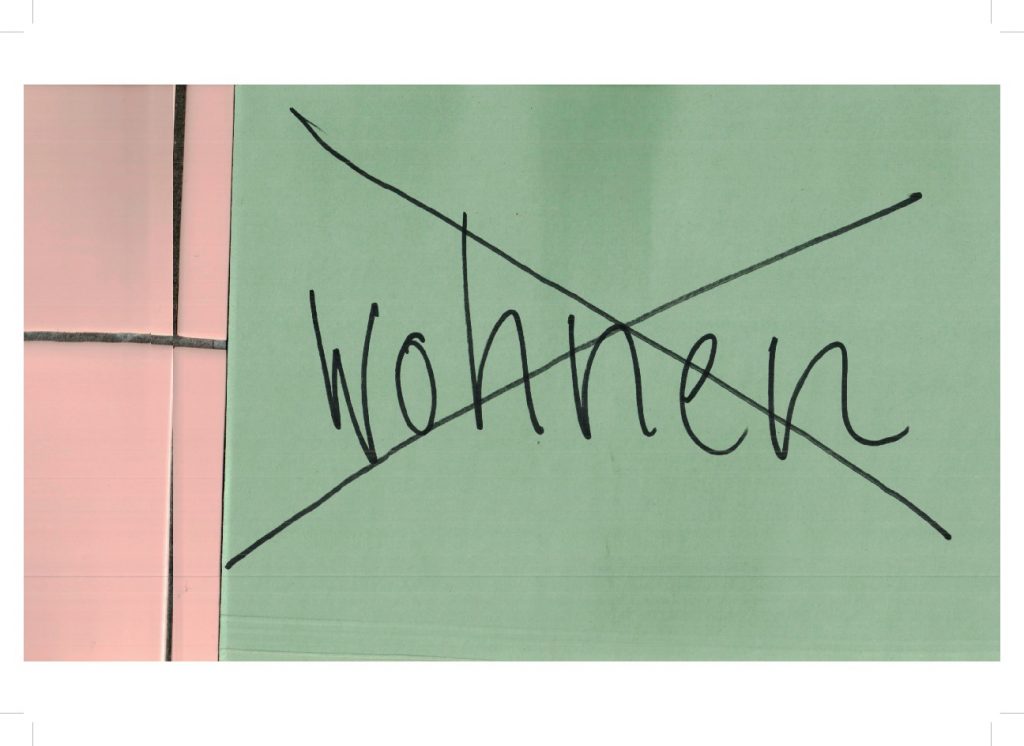Suchan Kinoshita
Snellopende laatbloeier oder das A und O vom
02.09.2018 — 14.10.2018
[NL]
Als reactie op administratieve moeilijkheden bij de aanvraag van een woonvergunning voor een pand dat oorspronkelijk een koetshuis was, daarna een opslagruimte voor glasobjecten uit Tsjechië en nu haar atelier is, heeft Suchan Kinoshita besloten dat ze niet meer wil wonen: Wohnen.
Wanneer men het ‘Ministerieel besluit van de Brusselse Hoofdstedelijke Regering van 23 januari 2014, verschenen in het Belgisch Staatsblad van 07.02.2014’ erop naleest, met al zijn definities en specificaties van wat wonen is en waaraan bijgevolg een woning dient te voldoen, wordt men inderdaad moedeloos. Regels zoals “Elk vertrek is voorzien van een lichtpunt met schakelaar” zijn slechts het topje van de ijsberg. De woning dient volledig gecompartimenteerd te zijn, en bij iedere ruimte zijn standaarden opgesteld waaraan de kamer in kwestie moet voldoen. Dit beïnvloedt het gebruik van de ruimtes: de invulling van het wonen is (daardoor) strikt genomen niet meer vrij. Activiteiten zoals koken, eten, slapen, werken, wassen, … vereisen aparte zones (al dan niet ommuurd).
In hoeverre is er nog een verband met wat ‘wonen’ oorspronkelijk betekende? De Germaanse wortel WEN en het Sanskrit VAN (zie ook het Latijnse Venus) betekenen ‘graag hebben’, ‘beminnen’. Via het Oudnoorse ‘una’ en het Gotische ‘wunan’, wat ‘zich verheugen’ wil zeggen, vgl. Duits ‘Wonne’ (=gelukzaligheid, verrukking), en het Oud-Ierse ‘fonn’ (wat genot betekent, denk aan ‘fun’) ontwikkelen de klanken zich tot (ons) Middelnederlands ‘wonen’ en het Nieuw Hoogduits ‘wohnen’. De grondbetekenis is dus: ergens graag vertoeven. Uit de Indo-Germaanse wortel WEN ontwikkelt zich in de West-Germaanse talen (gi-)wuna, wat ‘zich gewennen’, ‘gewoonte’ betekent. Wonen is m.a.w. rechtstreeks verbonden met een positief aspect van het leven.
Kan men zich dan in onze samenleving aan wonen onttrekken? Er wordt beweerd dat dit onmogelijk is. Je kunt niet niet wonen. Door dit evidente karakter krijgt wonen een existentiële dimensie.
Ook de Duitse filosoof Martin Heidegger (1889-1976) denkt er zo over. Wonen is volgens hem onze fundamentele toestand hier op aarde. In zijn essay Bauen, Wohnen, Denken (1951) betoogt hij dat wonen de manier is waarop wij zijn; het is de enige manier waarop de mens op deze aarde kan zijn. Heidegger leidt deze betekenis af van het Oudhoogduitse woord ‘buan’ dat volgens hem tegelijkertijd ‘bouwen’, ‘wonen’ en ‘ik ben’ betekent. M.a.w. ik woon, dus ik ben. Of omgekeerd.
In 1951 houdt Heidegger een voordracht waarin hij zegt dat er sprake is van een crisis in het wonen. Dit komt zijns inziens niet door het naoorlogse woningtekort of door gebrekkige bouwtechnieken, maar door het ontbreken aan inzicht in de essentie van wat wonen is. Sinds de negentiende eeuw is de mens overal en nergens thuis. Er is geen geestelijke band meer met de plek waar gewoond wordt. De mens heeft alleen nog een instrumentele houding tegenover de wereld, nut en efficiëntie primeren. Ook in het wonen. Anders gezegd, dat mensen een huis hebben, wil niet zeggen dat zij (er) werkelijk wonen.
We kennen allemaal de huisjesslak en de schildpad waarbij wonen, werken en slapen zich op dezelfde plaats afspelen. Bij hen vormt dit één geheel. Geen nest om te verlaten (of naar terug te keren), geen andere locatie om te rusten, te schuilen, te overwinteren. Doordat ze hun woning steeds bij zich hebben als ze ‘aan het werken’ zijn, vervaagt het onderscheid tussen beide. Of ze in hun woning werken of op hun werk wonen is niet meer relevant, wonen en werken kunnen niet anders dan samenvallen. In die zin zijn zij ononderbroken aan het werk.
Voor Suchan Kinoshita zijn werken en wonen één. In deze tentoonstelling wordt de geschiedenis van haar nieuwe pand stukje bij beetje blootgelegd. Ze ontdekte ter plaatse nieuwe materialen (zoals pek in een ondergronds reservoir, ijzeren ankers in de zijgevel, oude balken onder het dak) en daarmee herschept ze hier ruimtes. Vijf oude ankers, aan de buitenkant gebogen in de vorm van een letter, stutten vroeger de zijmuren. Vier van de vijf letters O – S – C – A – (R) zaten nog in de gevel toen Kinoshita het pand verwierf. Zij verandert de volgorde in C A O S (“chaos”).
Hier start de anatomie van het wonen, das A und O vom wohnen. Alfa en omega. Door minimale veranderingen ontstaan nieuwe zones in de tentoonstellingsruimte.
Wat het pand van Suchan Kinoshita prijsgegeven heeft tot nu toe vormt de achtergrond waartegen de tentoonstelling zich ontwikkelt. Zowel met specifieke elementen en materialen als in de vorm van mentale processen: Hoe zich te verhouden tot een bestaande situatie? Want ook de ruimte van LLS Paleis is nog niet af, en toont bij elke nieuwe tentoonstelling andere accenten.
Eén kamer in het huis in Brussel heeft een heel eigen karakter, en dat is de ‘hanare’. Ze ligt onder de nok van het dak, met enkel een steile trap die er naartoe leidt. In Japan is de hanare een aparte plaats naast de woonruimte. Het is een plek om afstand te nemen van het dagelijkse. Dit gebeurt in de laatste ruimte: Er staan twee stoelen en een prent “Le Jardin Japonais” (eigenlijk een weergave van een Chinese tafel), waarin de zittende figuren kijken naar een fictief model, dat wonen voorstelt…
Stella Lohaus, augustus 2018
Ter gelegenheid van de tentoonstelling maakte Suchan Kinoshita DAGBLAD No. 3. (met afbeeldingen uitsluitend in de vorm van scans) te koop voor € 40 (voor Sympathisanten LLS € 32) in LLS Paleis.
Op zondag 7 oktober (14-18h) wordt de nieuwe editie van Suchan Kinoshita voor LLS Paleis gepresenteerd: 20 unieke zeefdrukken in leem en chocolade.
Met de steun van de Vlaamse overheid
Gesponsord door Duvel Moortgat en Sampa Tea Company
Met dank aan Jos Augustijnen, Nadia Bijl, Frederic Blondeel (chocolatier, Brussel), Dora Brams, Liska Brams, Kris Cuylits, Alima de Graaf, Kaia de Graaf, Bram Denkens, Olivier Foulon, Oscar Hugal, Inga Krüger, Lux Maison en All Printing Services Antwerpen.

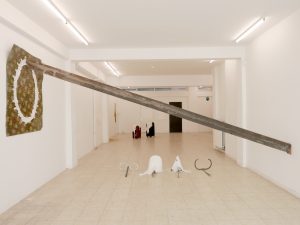
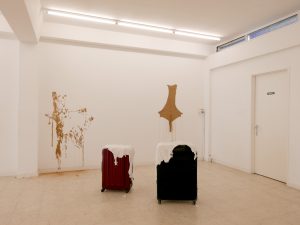
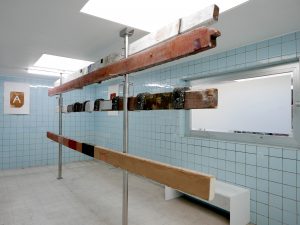
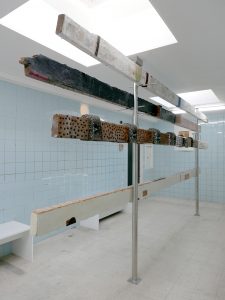
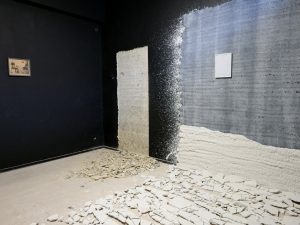
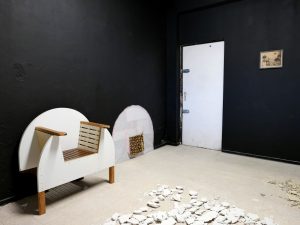
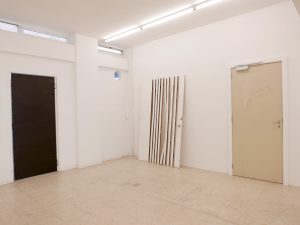
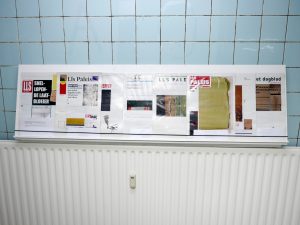
[EN]
In response to administrative difficulties when applying for a residential permit for a building that was originally a coach house, then a warehouse for glass objects from Czech Republic and is now her studio, Suchan Kinoshita has decided she does not want to be housed any longer: wohnen.
Anyone who reads the ‘Ministerial Decree of the Brussels-Capital Government of 23 January 2014, published in the Belgian Official Gazette of 07.02.2014’, with its definitions and specifications of housing and what criteria a residence must meet, will become discouraged indeed. Rules like “Each room is fitted with a light point with switch” are just the tip of the iceberg. The house must be divided entirely in compartments, and every space must meet standards specific to the room in question. This impacts the use of the spaces: the interpretation of inhabiting a space is strictly speaking no longer free. Activities like cooking, eating, sleeping, working, doing the laundry,… require separate zones (whether walled or not).
To what extent is there still a connection with the original meaning of ’to be housed’, ’to inhabit’ (‘wonen’)? The Germanic root WEN and the Sanskrit VAN (see also the Latin Venus) signify ’to like’, ’to love’. Through the Old Norwegian ‘una’ and the Gothic ‘wunan’, which means ’to rejoice oneself’, cf. German ‘Wonne’ (=joy, bliss), and the Old-Irish ‘fonn’ (meaning ‘joy’; think ‘fun’) the sounds developped into the Middle Dutch word ‘wonen’ and the New High Germanic ‘wohnen’. So the basic meaning is: to enjoy being somewhere. The Indo-Germanic root WEN developped into (gi-)wuna in the West-Germanic languages, meaning ’to accustom oneself’ (‘gewennen’), ‘habit’ (‘gewoonte’). In other words, ‘wonen’, to inhabit or be housed, is directly associated with a positive aspect of life.
Can people withdraw from inhabiting, ‘wonen’ in our society? It is claimed that this is impossible. One cannot not inhabit a residence. Because of this evident nature, inhabiting a space is given an existential dimension.
That is how German philosopher Martin Heidegger (1889-1976) saw it as well. To him, to inhabit, wohnen, is our fundamental condition here on earth. In his essay Bauen, Wohnen, Denken (1951) he argues that wohnen is our way of being; it is the only way man can be on earth. Heidegger derives this meaning from the Old High Germanic word ‘buan’ that to him simultaneously means ’to build’, ’to inhabit’ and ‘I am’. In other words: I inhabit, therefore I am. Or vice versa.
In 1951, Heidegger gave a lecture in which he said that there is a crisis in Wohnen. He argued it does not result from a post-war housing shortage, or inadequate construction techniques, but because of a lack of insight into the essence of what housing is. Since the nineteenth century, man has been at home everywhere and nowhere. The spiritual connection to the place where people live has been lost. Man only has an instrumental attitude towards the world, usefulness and efficiency predominate. This applies to wohnen as well. In other words, the fact that people own a house does not imply they actually inhabit it.
We all know the snail and the turtle that live, work and sleep at the same place. For them, this constitutes a whole. There’s no nest to leave (or return to), no place for rest, no shelter or place to hibernate. Since they always carry their home with them when ‘at work’, the distinction between the two is blurred. Whether they are working at home or living at work is no longer relevant, home and work cannot but coincide. In that sense, they are continuously at work.
For Suchan Kinoshita, work and wonen are one. Piece by piece the exhibition reveals the history of her new building. She discovered new materials (like pitch in an underground reservoir, iron armatures in the side wall, old beams under the roof) at the site and she uses them to reshape spaces here. Five old armatures, externally bent to form a letter, used to support the side walls. Four of the five letters O – S – C – A – (R) were still present in the facade when Kinoshita acquired the building. She changed their order to C A O S (“chaos”).
This is where the anatomy of housing, das A und O vom wohnen, starts. Alpha and omega. New zones are created in the exhibition space through minimalistic changes.
Everything the building of Suchan Kinoshita has yielded so far constitutes the background on which the exhibition develops. Both specific elements and materials, and mental processes: How to relate to an existing situation? Because the space of LLS Paleis is not finished yet either, it presents new accents with every new exhibition.
One room of the house in Brussels has its own specific character, the ‘hanare’. It is situated underneath the ridge of the roof, with only a steep staircase leading to it. In Japan, a hanare is a separate place next to main house. It is a place where one can distance oneself from daily life. This is what happens in the last space: it has two chairs and a picture “Le Jardin Japonais” (which actually represents a Chinese table), in which seated figures look at a fictional model representing wonen…
Stella Lohaus, August 2018
On the occasion of the exhibition, Suchan Kinoshita made DAGBLAD No. 3 (with reproductions only as scans) on sale for € 40 (for Sympathisanten LLS € 32) at LLS Paleis.
On Sunday October 7th, from 2-6 pm, we present the new edition by Suchan Kinoshita for LLS Paleis: 20 unique silkscreens in clay and chocolate.
With the support of the Flemish government
Sponsored by Duvel Moortgat and Sampa Tea Company
With thanks to Jos Augustijnen, Nadia Bijl, Frederic Blondeel (chocolatier, Brussel), Dora Brams, Liska Brams, Kris Cuylits, Alima de Graaf, Kaia de Graaf, Bram Denkens, Olivier Foulon, Oscar Hugal, Inga Krüger, Lux Maison and All Printing Services Antwerp.
